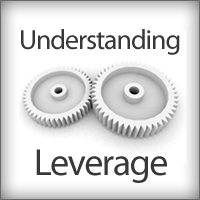Without leverage, Forex trading would be practically pointless for most retail traders.
But while it’s one of the most important distinguishing characteristics of Forex trading, I find that many traders are still in the dark about how leverage actually works.
So what is Leverage in Forex trading, really?
To understand leverage, we’ll first have to take a look at what trading would be like, without it.
Let’s say we have $5,000 U.S. dollars to start with.
1) We go to the money changer and see the EUR/USD trading at 1.4000.
2) Because we expect the Euro to appreciate against the U.S dollar in the near future, we trade our $5,000 USD to get 3,571 Euros.
3) One week later, the Euro has indeed appreciated and is trading at 1.4200. Ignoring spread costs, if we trade our Euros for USD, we’ll get back $5,071 USD. That’s a $71 USD profit, or a 1.4% gain – an amount hardly worth the effort.
Now, this is where leverage makes the difference.
1) We open up our trading platform and see the EUR/USD trading at 1.4000.
2) We expect the Euro to appreciate against the U.S. dollar in the near future, so we take a buy trade for 3 mini lots (or 30,000 Euros). What happens here is that we buy 30,000 Euros with $42,000 USD.
3) One week later, the Euro appreciates to 1.4200 and we trade our Euros back to get $42,600 USD. That’s a $600 USD profit, or a 12% gain. Now we’re talking!
Obviously, we made more money in the second example because we’re trading with a larger amount of currency. But how can we trade with $42,000 USD, if we only have $5,000 USD in our account?
The answer is that the broker “loans” the money to us.
That’s what leveraged trading essentially means: trading with “borrowed” money.
What? The broker actually loans us money to trade with? That’s really cool of them!
Hold your horses… it’s not that simple.
You see, although the broker really does allow us to trade with a larger volume of currency than we have in our accounts, we will bear the full amount of all profits and losses incurred. (This involves a concept called margin).
How to Calculate Leverage in Forex Trading
Leverage is commonly quoted as a multiple of the capital in your trading account.
So if you have a $3,000 account and you trade $30,000 worth of currency, you’re trading with 10 times leverage, or a leverage of 1:10.
If you have a $3,000 account and you trade $60,000 worth of currency, you’re trading with 20 times leverage, or a leverage of 1:20.
In this way, your trading leverage changes based on the size of the trades taken.
The larger your trades, the more leverage you use.
Maximum Leverage or Actual Leverage?
The above examples are how leverage is properly calculated. It’s the actual leverage you use while trading.
This is often confused with maximum leverage, which is the maximum amount of currency your broker allows you to trade with, based on your account capital.
With the same example:
If you have a $3,000 account and your maximum leverage is 1:50, your broker allows you to trade up to a maximum of $150,000 of currency (50 times $3,000).
However, if you understand how leverage (and margin) works, you should never trade anywhere close to that amount.
Although your maximum leverage is 1:50, if you trade $30,000 of currency, your actual leverage is 1:10 (10 times $3,000).
The Bottom Line
As you already know, trading leverage cuts both ways. The more leverage you use, the larger your profits and losses.
However, it’s NOT the maximum leverage that gets you into trouble… it’s the actual leverage that does.
Your broker cannot force you to use the maximum leverage – only you can decide how much leverage you use, via the volume of currency (lot size) you choose to trade with.
Traders who blame their brokers for providing “excessive” leverage are thus masking their ignorance behind misplaced anger.
I don’t care if my broker gives me a maximum leverage of 1:1000. It doesn’t matter. As long as I don’t trade with too large a lot size, my account will never be at risk of a wipe out.
It is not the tool that kills, but an ignorant wielder.
(This post continues on to talk about trading Margin, here.)

If I were a Teenage Mutant Ninja Turtle, now I’d say “Kowanbuga, dude!”
The way I approach leverage is to first take into account how much I am willing to lose if the trade goes against me, generally 1/1.5% of my equity. For example if I have 1000 USD account I factor in a potential 10$ loss per a trade. With that in mind I also factor in natural volatility into the price movement, which means the price will swing either way in the short run.
On this basis over-leveraging would mean I would likely get wiped out even if the price does eventually move in my favor. This setup then forces me to first pick areas of significant support/resistance, but also use leverage that gives the price enough breathing room to move within a range that is still consistent with the overall direction I expect it to take. I never understood the need for 1:1000 leverage, which probably appeals to very speculative traders.